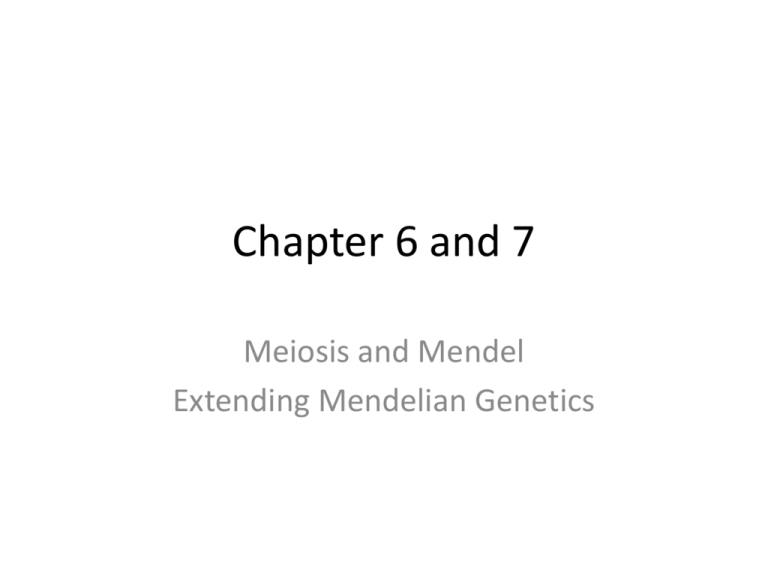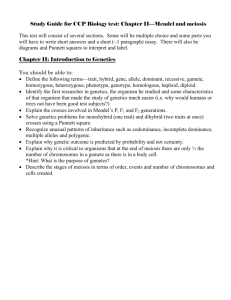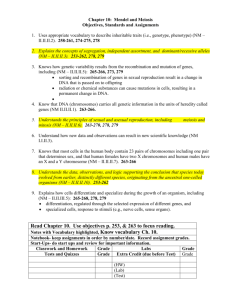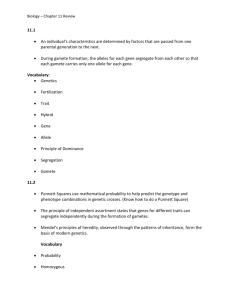Chapter 6 and 7 - Ms. Clark's Science
advertisement

Chapter 6 and 7 Meiosis and Mendel Extending Mendelian Genetics Warm up (2-23-16) Explain what you remember from middle school about genetics (Think about phenotype and genotype, think about Punnett Squares, think about Mendel, and gene inheritance.) Outline • Objectives • Chromosomes and Meiosis • Review genetics and what was discussed in middle school Objectives • Students will be able to identify the difference between sex cells and somatic cells and explain why these two types of cells are different. • Students will be able to identify the number of chromosomes present in sex cells versus somatic cells. Warm up (2-24-16) Explain the difference between diploid and haploid and what those terms mean. Outline • Objectives • Make a baby worksheet Objectives • Students will be able to identify the difference between sex cells and somatic cells and explain why these two types of cells are different. • Students will be able to identify the number of chromosomes present in sex cells versus somatic cells. Make a baby worksheet • Pick a partner and walk your way through the worksheet. • This will give us an introduction to genetics and how gene inheritance works. Warm up (2-25-16) How many cells go into the process of meiosis? How many cells come out of the process of meiosis? Please explain how many chromosomes are in the cells going into meiosis and how many chromosomes are in the cells coming out of meiosis. Outline • Objectives • Process of Meiosis notes • Meiosis Drawings Objectives • Students will be able to identify the difference between sex cells and somatic cells and explain why these two types of cells are different. • Students will be able to identify the steps in meiosis and explain what is occurring to the chromosomes at each step Warm up (2-26-16) What are the phases of meiosis? Please be specific and indicate which division those phases are associated with. Outline • Objectives • Finish Meiosis notes • 6.1 and 6.2 section review questions Objectives • Students will be able to identify the difference between sex cells and somatic cells and explain why these two types of cells are different. • Students will be able to identify the steps in meiosis and explain what is occurring to the chromosomes at each step Warm up (2-29-16) Explain what genetics is and how specific traits can be determined for organisms. Outline • • • • • Objectives Read 6.3 Mendel and Genetics Heredity video Mendel and Heredity Objectives • Students will be able to identify the difference between sex cells and somatic cells and explain why these two types of cells are different. • Students will be able to identify the steps in meiosis and explain what is occurring to the chromosomes at each step 6.1 Notes • Gametes have half the number of chromosomes that body cells have – There are body cells and gametes • Somatic cells: body cells, make up most of your body tissues and organs • Gametes: sex cells, egg in the female and sperm in the male Your body cells have autosomes and sex chromosomes – Homologous chromosomes: 2 chromosomes • “having the same structure” • One from mother, one from father • Have copies of the same genes although the copies may be different – Numbered from the largest chromosome to the smallest – Autosomes: chromosomes numbers 1-22 • Chromosomes contain genes for characteristics not directly related to the sex of the organism Your body cells have autosomes and sex chromosomes – Sex chromosomes: directly control the development of sexual characteristics • All mammals are based on the X and Y system • This is the 23rd pair of chromosomes • X and Y are paired together but they are not homologous – X chromosome is larger, contains many genes, even some unrelated to sexual characteristics – Y chromosome is smallest, carries fewest genes, contains genes in direct development of male traits Body cells are diploid, Gametes are haploid • Sexual Reproduction: fusion of two gametes which results in the production of offspring that are a genetic mixture of both parents – Fertilization: actual fusion of egg and sperm • Diploid: a cell has two copies of each chromosome – – – – One from mother, one from father 2n In humans, diploid number is 46 ***What would the haploid number be?**** Body cells are diploid, Gametes are haploid • Haploid: a cell has only one copy of each chromosome –n – Human gametes • Maintaining the correct number of chromosomes is important to the survival of all organisms – Typically change in number is harmful, but on occasion increasing number of sets can give rise to new species Warm up (3-1-16) Explain Mendel’s experiments in your own words. Explain why his work was important. Outline • • • • • • Objectives Mendel and Heredity Notes 6.3 Read 6.4 Notes 6.4 Intro 6.5 Objectives • Students will be able to identify the difference between sex cells and somatic cells and explain why these two types of cells are different. • Students will be able to identify the steps in meiosis and explain what is occurring to the chromosomes at each step Meiosis • A form of nuclear division that divides a diploid cell into haploid cells – Essential for sexual reproduction • Occurs in germ cells to produce gametes • “reduction division” – reduce chromosome number by half • DNA is copied once but divided twice • Genetically unique haploid cells form from a diploid cell Process of Meiosis Meiosis Video • https://www.khanacademy.org/science/biolog y/cellular-molecular-biology/new-topic-201406-18T18:00:45.081Z/v/phases-of-meiosis • https://www.youtube.com/watch?v=16enC38 5R0w Meiosis I Prophase I Metaphase I Anaphase I Telophase I Cytokinesis Meiosis II Prophase II Metaphase II Anaphase II Telophase II Cytokinesis Meiosis Drawings and Notes on the Phases • Take a few minutes and use your paper to draw the phases of meiosis. • You may use the book if you need to • We will be taking notes on the lines next to the drawings so please try to keep your drawings small enough to not cover the lines. Warm up (3-2-16) What is the law of segregation? What are traits, genes, and alleles? Use these terms and explain how each of these terms is involved in genetics. Outline • • • • Objectives 6.5 Notes Punnett Square practice - Bunny game Chapter 6.1-6.3 Quiz Objectives • Students will be able to identify the difference between sex cells and somatic cells and explain why these two types of cells are different. • Students will be able to identify the steps in meiosis and explain what is occurring to the chromosomes at each step Meiosis • A form of nuclear division that divides a diploid cell into haploid cells – Essential for sexual reproduction • Occurs in germ cells to produce gametes • “reduction division” – reduce chromosome number by half • DNA is copied once but divided twice • Genetically unique haploid cells form from a diploid cell Meiosis Video • https://www.khanacademy.org/science/biolog y/cellular-molecular-biology/new-topic-201406-18T18:00:45.081Z/v/phases-of-meiosis • https://www.youtube.com/watch?v=16enC38 5R0w 6.3 Notes - Mendel and Heredity • Mendel’s research showed that traits are inherited as discrete units – Mendel laid the groundwork for genetics • Traits: distinguishing characteristics that are inherited • Genetics: study of biological inheritance – Mendel’s Data revealed patterns of inheritance • Purebred: genetically uniform • Mendel chose 7 traits to look at – Mendel controlled pollination by removing stamens KEY CONCEPT Mendel’s research showed that traits are inherited as discrete units. Mendel laid the groundwork for genetics. • Traits are distinguishing characteristics that are inherited. • Genetics is the study of biological inheritance patterns and variation. • Gregor Mendel showed that traits are inherited as discrete units. • Many in Mendel’s day thought traits were blended. Warm up (3-3-16) Perform the following cross by using a Punnett Square: BB x Bb Outline • Objectives • I do - we do - you do Punnett Square practice • Punnett Square worksheet Objectives • Students will be able to identify the difference between sex cells and somatic cells and explain why these two types of cells are different. • Students will be able to identify the steps in meiosis and explain what is occurring to the chromosomes at each step Mendel’s data revealed patterns of inheritance. • Mendel made three key decisions in his experiments. – use of purebred plants – control over breeding – observation of seven “either-or” traits • Mendel used pollen to fertilize selected pea plants. – P generation crossed to produce F1 generation – interrupted the self-pollination process by removing male flower parts Mendel controlled the fertilization of his pea plants by removing the male parts, or stamens. He then fertilized the female part, or pistil, with pollen from a different pea plant. • Mendel allowed the resulting plants to self-pollinate. – Among the F1 generation, all plants had purple flowers – F1 plants are all heterozygous – Among the F2 generation, some plants had purple flowers and some had white • Mendel observed patterns in the first and second generations of his crosses. • Mendel drew three important conclusions. – Traits are inherited as discrete units. – Organisms inherit two copies of each gene, one from each parent. – The two copies segregate during gamete formation. – The last two conclusions are called the law of segregation. purple white Warm up (3-4-16) Explain the process of using a Punnett Square. Can a Punnett Square be larger than 4 squares? If so, explain how. Outline • • • • Objectives Reading Ch. 6.6 Notes 6.5 (?) and 6.6 Chapter 6 Quizzes Objectives • Students will be able to identify the difference between sex cells and somatic cells and explain why these two types of cells are different. • Students will be able to identify the steps in meiosis and explain what is occurring to the chromosomes at each step 6.4 Notes KEY CONCEPT Genes encode proteins that produce a diverse range of traits. The same gene can have many versions. • A gene is a piece of DNA that directs a cell to make a certain protein. • Each gene has a locus, a specific position on a pair of homologous chromosomes. • An allele is any alternative form of a gene occurring at a specific locus on a chromosome. – Each parent donates one allele for every gene. – Homozygous describes two alleles that are the same at a specific locus. – Heterozygous describes two alleles that are different at a specific locus. Genes influence the development of traits. • All of an organism’s genetic material is called the genome. • A genotype refers to the makeup of a specific set of genes. • A phenotype is the physical expression of a trait. • Alleles can be represented using letters. – A dominant allele is expressed as a phenotype when at least one allele is dominant. – A recessive allele is expressed as a phenotype only when two copies are present. – Dominant alleles are represented by uppercase letters; recessive alleles by lowercase letters. • Both homozygous dominant and heterozygous genotypes yield a dominant phenotype. • Most traits occur in a range and do not follow simple dominant-recessive patterns. Warm up (3-7-16) Explain what crossing over is and which stage of meiosis this process occurs in. Outline • Objectives • 6.6 Reading and Notes • Make a “baby” genetics project Objectives • Students will be able to identify the difference between sex cells and somatic cells and explain why these two types of cells are different. • Students will be able to identify the steps in meiosis and explain what is occurring to the chromosomes at each step Warm up (3-8-16) Explain what causes traits to be passed down to offspring from the parents. (Use the words, traits, alleles, dominant, recessive, heterozygous, and homozygous in your answer.) Outline • Objectives • Genetics Project – Offspring Creation • Mini partner quiz Objectives • Students will be able to identify the difference between sex cells and somatic cells and explain why these two types of cells are different. • Students will be able to identify the steps in meiosis and explain what is occurring to the chromosomes at each step Warm up (3-9-16) Explain how phenotype is determined for genetic crosses. (Don’t forget to mention which alleles must be present for specific phenotypes to appear.) Outline • Objectives • Chapter 7 Intro Objectives • Describe how sexual reproduction creates unique gene combinations • Explain how crossing over during meiosis increases genetic diversity Video: Genetics and Heredity • https://www.youtube.com/watch?v=NWqgZU nJdAY Warm up (3-10-16) What does it mean if there is codominance for a particular gene? Outline • • • • • Objectives Genetics video Quick lab p. 185 Allele Combinations p. 188 Bunny Game! Objectives • Describe how sexual reproduction creates unique gene combinations • Explain how crossing over during meiosis increases genetic diversity Punnett Square Practice • Composition notebooks to the next page. • P. 185 in your books – Quick Lab • P. 188 in your books – Allele combinations and Punnett Squares Punnett Square Practice • Bunny Game • http://vital.cs.ohiou.edu/steamwebsite/downl oads/FurryFamily.swf I do - We do - You do • Punnett Square Practice Punnett Square Worksheet Warm up (3-14-16) Explain how sexual reproduction generates new allele combinations in offspring. Outline • Objectives • Bunny Game! • 6.5 and 6.6 Notes Objectives • Describe how sexual reproduction creates unique gene combinations • Explain how crossing over during meiosis increases genetic diversity 6.5 Notes KEY CONCEPT The inheritance of traits follows the rules of probability. Punnett squares illustrate genetic crosses. • The Punnett square is a grid system for predicting all possible genotypes resulting from a cross. – The axes represent the possible gametes of each parent. – The boxes show the possible genotypes of the offspring. • The Punnett square yields the ratio of possible genotypes and phenotypes. A monohybrid cross involves one trait. • Monohybrid crosses examine the inheritance of only one specific trait. – homozygous dominant-homozygous recessive: all heterozygous, all dominant – heterozygous-heterozygous—1:2:1 homozygous dominant: heterozygous:homozygous recessive; 3:1 dominant:recessive • heterozygous-homozygous recessive—1:1 heterozygous:homozygous recessive; 1:1 dominant:recessive • A testcross is a cross between an organism with an unknown genotype and an organism with the recessive phenotype. A dihybrid cross involves two traits. • Mendel’s dihybrid crosses with heterozygous plants yielded a 9:3:3:1 phenotypic ratio. • Mendel’s dihybrid crosses led to his second law, the law of independent assortment. • The law of independent assortment states that allele pairs separate independently of each other during meiosis. Heredity patterns can be calculated with probability. • Probability is the likelihood that something will happen. • Probability predicts an average number of occurrences, not an exact number of occurrences. • Probability = number of ways a specific event can occur number of total possible outcomes • Probability applies to random events such as meiosis and fertilization. 6.6 Notes KEY CONCEPT Independent assortment and crossing over during meiosis result in genetic diversity. Sexual reproduction creates unique combinations of genes. • Sexual reproduction creates unique combination of genes. – independent assortment of chromosomes in meiosis – random fertilization of gametes • Unique phenotypes may give a reproductive advantage to some organisms. Crossing over during meiosis increases genetic diversity. • Crossing over is the exchange of chromosome segments between homologous chromosomes. – occurs during prophase I of meiosis I – results in new combinations of genes • Chromosomes contain many genes. – The farther apart two genes are located on a chromosome, the more likely they are to be separated by crossing over. – Genes located close together on a chromosome tend to be inherited together, which is called genetic linkage. • Genetic linkage allows the distance between two genes to be calculated. Genetics Project – Offspring Creation • Chromosomes contain many genes. – The farther apart two genes are located on a chromosome, the more likely they are to be separated by crossing over. – Genes located close together on a chromosome tend to be inherited together, which is called genetic linkage. • Genetic linkage allows the distance between two genes to be calculated. Mini Quiz • Complete the following crosses using simple Punnett Squares – BB x Bb – Yy x yy – Hh x Hh • Find the percentage of dominant phenotypes for each of the crosses • Find the percentage of recessive phenotypes for each of the crosses • Now, use the following table to help identify the phenotypes of the offspring. Flower color Fruit Color Plant Height DOMINANT Blue (B) Yellow (Y) Tall (H) RECESSIVE White (b) Green (y) Short (h) Warm up (3-15-16) Describe how sex-linked genes are expressed differently in males and females. Outline • • • • Objectives Read ch. 7.1 Notes ch. 7.1 Sex linked inheritance p. 202 Objectives • Describe how sexual reproduction creates unique gene combinations • Explain how crossing over during meiosis increases genetic diversity Extending Mendelian Genetics 7.1 KEY CONCEPT The chromosomes on which genes are located can affect the expression of traits. Two copies of each autosomal gene affect phenotype. • Mendel studied autosomal gene traits, like hair texture. • Mendel’s rules of inheritance apply to autosomal genetic disorders. – A heterozygote for a recessive disorder is a carrier. – Disorders caused by dominant alleles are uncommon. (dominant) Males and females can differ in sexlinked traits. • Genes on sex chromosomes are called sex-linked genes. – Y chromosome genes in mammals are responsible for male characteristics. – X chromosome genes in mammals affect many traits. • Male mammals have an XY genotype. – All of a male’s sexlinked genes are expressed. – Males have no second copies of sex-linked genes. • Female mammals have an XX genotype. – Expression of sex-linked genes is similar to autosomal genes in females. – X chromosome inactivation randomly “turns off” one X chromosome. Sex – Linked Inheritance • P. 202 • Problem – How does probability explain sexlinked inheritance – Answer this question as your prediction • Procedure – follow the procedure on page 202 • When you finish the procedure, answer the analysis and conclusion questions in your composition notebook using complete sentences. Warm up (3-16-16) Explain what happens during fertilization. (Include the terms – gametes, diploid and haploid in your answer) Outline • Objectives • Sex linked inheritance p. 202 Objectives • Describe how sexual reproduction creates unique gene combinations • Explain how crossing over during meiosis increases genetic diversity Sex – Linked Inheritance • P. 202 • Problem – How does probability explain sexlinked inheritance – Answer this question as your prediction • Procedure – follow the procedure on page 202 • When you finish the procedure, answer the analysis and conclusion questions in your composition notebook using complete sentences. 7.2 KEY CONCEPT Phenotype is affected by many different factors. Phenotype can depend on interactions of alleles. • In incomplete dominance, neither allele is completely dominant nor completely recessive. – Heterozygous phenotype is intermediate between the two homozygous phenotypes – Homozygous parental phenotypes not seen in F1 offspring • Codominant alleles will both be completely expressed. – Codominant alleles are neither dominant nor recessive. – The ABO blood types result from codominant alleles. • Many genes have more than two alleles. Many genes may interact to produce one trait. • Polygenic traits are produced by two or more genes. Order of dominance: brown > green > blue. • An epistatic gene can interfere with other genes. The environment interacts with genotype. • Phenotype is a combination of genotype and environment. • The sex of sea turtles depends on both genes and the environment • Height is an example of a phenotype strongly affected by the environment. Warm up (3-17-16) Explain what codominance is and give an example of a codominant trait. Outline • • • • Objectives Codominance p.208 Read 7.3 Notes 7.3 Objectives • Explore codominance by investigating the inheritance of sickle cell disease within a family • Infer genotypes using knowledge of heterozygous and homozygous alleles • Use punnett squares to predict patterns of gene inheritance and gene expression p. 208 Codominance • Read through the background information about sickle cell disease. Then follow the procedure to answer the 5 questions in your composition notebook. Please use complete sentences while working on this. 7.3 KEY CONCEPT Genes can be mapped to specific locations on chromosomes. Gene linkage was explained through fruit flies. • Morgan found that linked traits are on the same chromosome. • Chromosomes, not genes, assort independently during meiosis. Wild type Mutant • Linked genes are not inherited together every time. • Chromosomes exchange homologous genes during meiosis. Linkage maps estimate distances between genes. • The closer together two genes are, the more likely they will be inherited together. • Cross-over frequencies are related to distances between genes. • Linkage maps show the relative locations of genes. • Cross-over frequencies can be converted into map units. – gene A and gene B cross over 6.0 percent of the time – gene B and gene C cross over 12.5 percent of the time – gene A and gene C cross over 18.5 percent of the time Warm up (3-21-16) Outline • Objectives Objectives 7.4 KEY CONCEPT A combination of methods is used to study human genetics. Human genetics follows the patterns seen in other organisms. • The basic principles of genetics are the same in all sexually reproducing organisms. – Inheritance of many human traits is complex. – Single-gene traits are important in understanding human genetics. Females can carry sex-linked genetic disorders. • Males (XY) express all of their sex linked genes. • Expression of the disorder depends on which parent carries the allele and the sex of the child. Y X A pedigree is a chart for tracing genes in a family. • Phenotypes are used to infer genotypes on a pedigree. • Autosomal genes show different patterns on a pedigree than sex-linked genes. • If the phenotype is more common in males, the gene is likely sex-linked. Several methods help map human chromosomes. • A karyotype is a picture of all chromosomes in a cell. XY • Karyotypes can show changes in chromosomes. – deletion of part of a chromosome or loss of a chromosome – large changes in chromosomes – extra chromosomes or duplication of part of a chromosome Blood Smears Warm up (3-27-15) Explain how particular traits can be polygenic traits. Provide an example of polygenic traits. Outline • Objectives • Chapter 7 quizzes • Take home test for homework Objectives • Students will be able to identify the difference between sex cells and somatic cells and explain why these two types of cells are different. • Students will be able to identify the steps in meiosis and explain what is occurring to the chromosomes at each step Blood Typing Chapter 6-7 Quiz Blood Typing • http://www.redcrossblood.org/learn-aboutblood/blood-types








